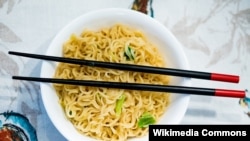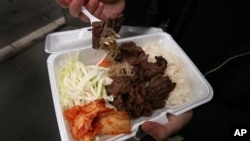Asian food is the fastest-growing cuisine in the United States.
Between 1999 and 2015, sales of Asian fast food rose 135 percent, beating Latin and Middle Eastern cuisines. That information comes from market research firm Euromonitor.
Several things are pushing this growth, says Andrew Coe. He wrote the 2009 book Chop Suey: A Cultural History of Chinese Food in the United States.
“A big change began in 1965 with the passage of the [Immigration and Nationality Act of 1965]. That opened the door for a lot of immigrants from Asian countries,” he said. “There are a lot more Asians from different countries, and they brought their food with them.”
A Pew Research Center report says there were 20 million Asian-Americans in 2017. That is an increase of 72 percent since 2000, making the Asian population the fastest-growing group in the country.
Coe said there are other reasons for Asian food’s sharp rise in popularity.
“American business is involved with every country in the world, and we’re very aware of other countries and cultures,” he said. “We’re interested in the things they eat — a lot more interested than we used to be.”
He noted that younger people are more willing to try new foods.
“Look at Korean. No one thought it would be hip. Now, it’s hip,” he said. Coe added that, with immigration, “we have those people here who can prepare the food correctly.”
Worldwide, about 90 percent of Asian restaurants are small and independent. But in the United States, large restaurant chains make up about 50 percent of sales of Asian cuisine. Panda Express is one example. It had $2 billion in sales in 2014, The Washington Post reported.
J. Sullivan is the head cook for Pei Wei Asian Diner, an Asian "fast casual" restaurant. The first Pei Wei opened in 2000. There are now more than 200 locations across the U.S.
Sullivan said Chinese food has been here long enough that people - especially younger people - are very familiar with it.
His first experience with Asian cuisine was 18 years ago. “I remember being blown away by not only unlocking the mysteries of Chinese food, but also exposure to Southeast Asian cuisine,” he said.
He added that people now want to eat healthier. Many kinds of Asian food are thought to be healthy because of the high amount of fresh ingredients and vegetables. But traditional American cuisine has very large servings and is heavy on protein and starch, Sullivan added.
He noted, however, that many favorite Asian dishes are full of calories. He said that is something he is trying to change.
Sullivan said that, thanks to the internet, Asian food recipes are more available than ever. And as the Asian population in America grows, more and more stores are selling key Asian ingredients that used to be hard to find. And if there is not an Asian market nearby, many ingredients are available online.
Sullivan also said Asian influences are affecting non-Asian food. He said more and more people come from a mix of cultures, so mixing cuisines is normal. Korean tacos, a popular dish, are just one example.
I’m Alice Bryant.
Matt Hilburn wrote this story for VOA News. Alice Bryant adapted it for Learning English. Ashley Thompson was the editor.
_______________________________________________________________
Words in This Story
aware – adj. knowing that something, such as a situation, condition, or problem, exists
hip – adj. very popular or fashionable
chain – n. a group of businesses, such as restaurants, that have the same name and basic appearance and sell the same products or services
ingredient – n. one of the things that are used to make a food or product
starch – n. a substance that is found in certain foods, such as bread, rice, and potatoes
calorie – n. a unit of heat used to indicate the amount of energy that foods will produce in the human body









